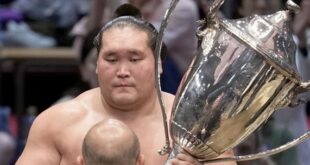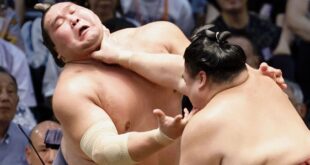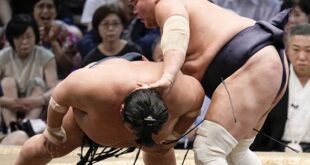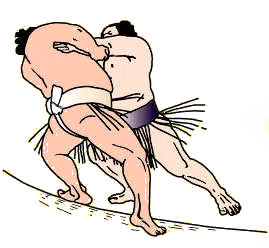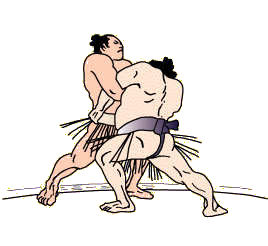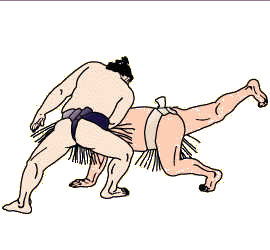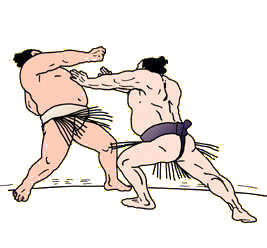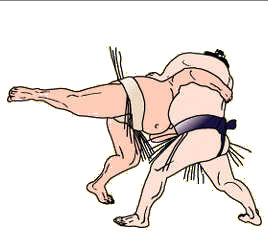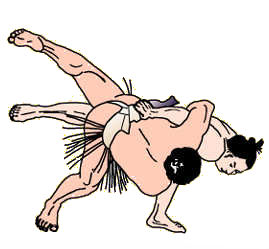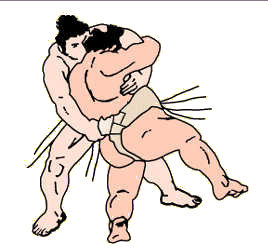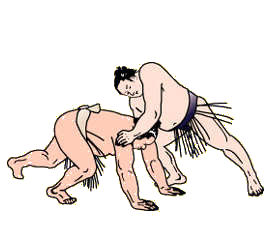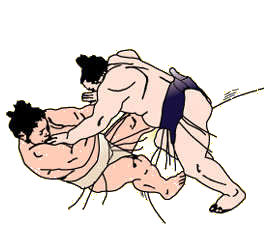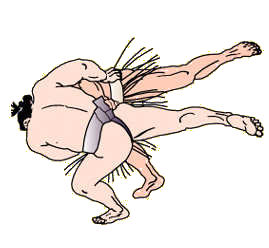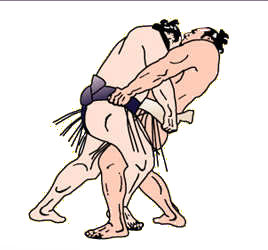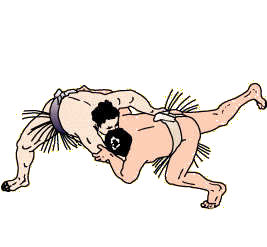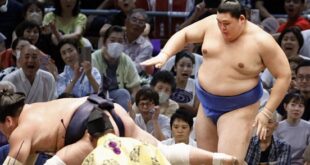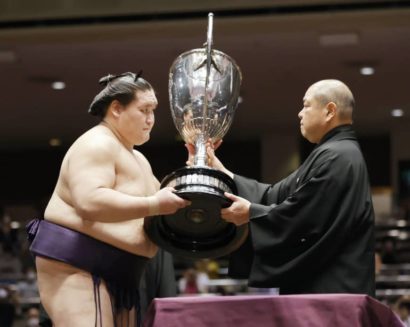
Dernier jour : Une deuxième coupe de l’Empereur pour le revenant Terunofuji
Alors qu’il y a un an, personne n’aurait misé un kopeck sur le makushita N°59, aujourd’hui en cette année 2020, le même rikishi Terunofuji est non seulement remonté en maegashira 17, mais il a remporté son deuxième yushô !! Près de 5 ans après sa première coupe en 2015, c’est bien lui qui a brandit aujourd’hui la mythique coupe de l’Empereur des mains du président de la NHK, l’association japonaise de sumô.
Bien inspiré aurait été celui qui aurait prévu ce final aujourd’hui ! Terunofuji, l’ex-ôzeki blessé, remonté des profondeurs de la division makushita, en dehors des catégories salariées, à un modeste rang 17 des maegashira au début du tournoi, en tête du classement provisoire avec 12 victoires après 14 jours de combats, affrontait sur le dohyô le sekiwake Mitakeumi, un des rikishis en forme !!
Le mongol de 28 ans, supérieur en taille et possédant une plus grande envergure de bras, réussit dès le tachi-ai à poser sa main gauche sur le mawashi du sekiwake alors que celui-ci essayait de lui bloquer les épaules en essayant de glisser les bras à l’intérieur sous les aisselles. Rien ne bloqua Terunofuji qui agrippa de la main droite l’autre côté du mawashi, puis se releva en transportant littéralement son opposant jusqu’à bord. L’esprit déterminé de Terunofuji avait fait reste :
« Quand je suis descendu dans le classement, il y avait des gens qui m’encourageaient : ma famille, mon maître d’écurie et tous les membres de mon écurie. Grâce à leur soutien, j’ai pu revenir », a-t-il déclaré. « Tant de choses se sont produites, mais à la toute fin, j’ai finalement affronté cette journée. Je croyais que ce jour viendrait où je pourrais sourire, que si je travaillais dur, je serais récompensé. »
Derrière le maegashira 17 vainqueur du yushô, on retrouve donc les acteurs habituels du haut du banzuke : en premier, le nouvel ôzeki Asanoyama, qui a pu se débarrasser sans problème du sekiwake Shodai qui lui disputait cette deuxième place. Le deuxième ôzeki, Takakeisho, blessé, ne sera pas kadoban car il a atteint les 8 victoires avant d’abandonner.
Comme le compère de Shodai, Mitakeumi, avait perdu contre Terunofuji, les deux sekiwake sont donc restés à 11 victoires et peuvent donc entamer tous les deux une course à l’accès au grade d’ôzeki. Il faudra renouveler leur score encore deux fois sur les deux prochains basho pour espérer y arriver.
Les komusubi, Daieisho et Okinoumi, ont dépassé tous les deux le kachikoshi (9 victoires pour Okinoumi, 11 pour Daieisho) et resteront solidement en place au prochain banzuke.
Enfin, les deux yokozuna blessés devront faire connaître leur décision de continuer. Pour Hakuhô, on sait déjà que l’heure de la retraite n’est pas arrivée, et que sa décision de quitter le tournoi était surtout motivée par sa volonté de ne pas aggraver sa blessure et pouvoir revenir au prochain tournoi, histoire de conquérir un nouveau titre. Désormais, seul le record de titres semble l’intéresser. Quant à Kakuryû, rien ne filtre pour le moment et il faudra attendre les prochains jours pour avoir des nouvelles.
A noter qu’Abi n’est toujours pas revenu…
En juryô, fait exceptionnel, il a fallu 5 combats de play-off (kettei-sen) avec les six lutteurs ex-aequos à 10 victoires, pour désigner le vainqueur du tournoi de la catégorie, en l’occurence le juryo 1 Meisei !!
Les lutteurs kachi koshi du jour sont :
Jûryô : Daishomaru, Midorifuji
Les lutteurs make koshi du jour sont :
Jûryô : Daiamami, Chiyotoori
Clic on the title bellow for article in English :
Terunofuji clinches championship in comeback tournament
Former ozeki Terunofuji completes a stunning comeback on Aug. 2, 2020 by clinching the July Grand Sumo Tournament with a final-day victory over sekiwake Mitakeumi. (Kyodo). A loss would have seen the Mongolian fall into a three-way tie with Mitakeumi (11-4) and ozeki Asanoyama (12-3), winner of the day’s final bout against sekiwake Shodai (11-4).
After taking an outside belt grip at the jump, Terunofuji quickly muscled fellow Outstanding Performance Award winner Mitakeumi out backwards to claim his first championship in more than five years. The native of Ulaanbaatar last fought in sumo’s elite makuuchi division in January 2018, before injuries to both knees and illness derailed his career. His one previous top-level championship came at the 2015 Summer Grand Tournament. Once a candidate for yokozuna promotion, he was demoted from the second-tier juryo division after the 2018 May tourney.
After missing four straight grand tournaments, he began his comeback last year in March’s Spring Grand Sumo Tournament in the sumo world’s next-to-lowest tier, the jonidan division, where he had bottomed out at No. 48.
The newly crowned champion gave credit to his family, stablemates and stablemaster Isegahama for their encouragement during his long climb back through the ranks after he had considered retiring on several occasions.
« When I went down the ranks, there were people who were rooting for me: my family, my stablemaster, and all the members of my stable. Thanks to their support I was able to come back, » he said. So many things have happened, but at the very end, I finally faced this day. I believed this day would come where I could smile, that if I worked hard, I would be rewarded. »
Following the injury withdrawal of grand champion and one-time tournament leader Hakuho after Day 12, the title had looked like a two-horse race between Terunofuji and Asanoyama. But after winning his meeting with Asanoyama on Day 13, Terunofuji blew a chance to secure the title the following day when he lost to Shodai. That result brought Shodai back into the race, while also keeping open the door for Asanoyama and Mitakeumi.
Asanoyama, meanwhile, missed a chance to move back into a tie for first place on Day 14 when he took his second straight loss at the hands of No. 7 Terutsuyoshi (8-7). But the new ozeki completed a strong showing in his debut tournament at sumo’s second-highest rank by outmaneuvering Shodai. Despite being denied his preferred grip, Asanoyama controlled the momentum and used his impressive strength to push out the powerful Shodai, who put his own name on the ozeki candidate list with his 11 wins.
Komusubi Daieisho earned his 11th win — and an Outstanding Performance Award along with it — by pulling down No. 10 Myogiryu (10-5). The 26-year-old from Saitama Prefecture finished a strong tournament with six straight wins on his way to an 11-4 record.
Komusubi Okinoumi (9-6) lost to No. 9 Tamawashi (10-5) in a battle between grapplers looking for their 10th win of the tournament. Okinoumi opened aggressively in search of a belt grip, but Tamawashi kept him off balance before executing an overarm throw.
The July meet was the first grand tournament held in four months following the cancellation of May’s event due to the novel coronavirus pandemic. It was moved from its traditional location in Nagoya to cut down on travel during the pandemic. Ryogoku Kokugikan had been kept to a quarter of its capacity to prevent the spread of the pneumonia-causing virus.
Source : The Mainichi

Champions par division :
Makuuchi : Terunofuji (13-2)
Maegashira 17 – Isegahama beya
Jûryô : Meisei (10-5)
Est 1 – Tatsunami beya
Makushita : Chiyonokuni (7-0)
Ouest 12 – Kokonoe beya
Sandanme : Fukai (7-0)
Est 67 – Takasago beya
Jonidan : Takeoka (7-0)
Est 84 – Oguruma beya
Jonokuchi : Hokuseiho (7-0)
Est 18– Miyagino beya
Prix spéciaux (sanshô) :
Shukun-shô : Mitakeumi (6ème), Daieishô (2ème) et Terunofuji (2ème)
Performance exceptionnelle
Kantô-shô : Shodai (5e),
Meilleur esprit combatif
Ginô-shô : Terunofuji (1er)
Prix de la technique
- Parution du banzuke : 31 Août
- Début du tournoi : 13 septembre
- Fin du tournoi : 27 septembre
Lieu : Tokyo (Ryogoku Kokugikan)
Merci à tous d’avoir suivi le tournoi jour après jour sur Dosukoi mais l’actualité du sumo continue même en dehors des basho. Toutes les informations des événements à venir sont sur notre site. N’oubliez pas de nous rejoindre sur les réseaux sociaux, suivez-nous sur Facebook et Twitter et abonnez-vous à notre chaîne YouTube. N’hésitez pas à partager les articles sur ces réseaux et à les commenter.
Enfin, merci à Sumo Natto pour ses vidéos quotidiennes ainsi qu’à tous nos lecteurs.
- Makuuchi
- Juryô
|
Rikishis
|
Score
|
Kimarites
|
Score
|
Rikishis
|
 Ichinojo
逸ノ城 (Juryo 5) |
|
|
|
|
 Shôhôzan
松鳳山 (Maegashira 12) |
|
 Sadanoumi
佐田の海 (Maegashira 12) |
|
|
|
|
 Nishikigi
錦木 (Maegashira 16) |
|
 Kotoshoho
琴勝峰 (Maegashira 15) |
|
|
|
|
 Tochinoshin
栃ノ心 (Maegashira 11) |
|
 Kaisei
魁聖 (Maegashira 10) |
|
|
|
|
 Shimanoumi
志摩ノ海 (Maegashira 11) |
|
 Ishiura
石浦 (Maegashira 8) |
|
|
|
|
 Wakatakakage
若隆景 (Maegashira 14) |
|
 Terutsuyoshi
照強 (Maegashira 7) |
|
|
|
|
 Kotoeko
琴恵光 (Maegashira 16) |
|
 Kotonowaka
琴ノ若 (Maegashira 13) |
|
|
|
|
 Ryuden
竜電 (Maegashira 6) |
|
 Kotoshôgiku
琴奨菊 (Maegashira 14) |
|
|
|
|
 |
|
 |
|
|
|
|
 Aoiyama
碧山 (Maegashira 4) |
|
 Kagayaki
輝 (Maegashira 4) |
|
|
|
|
 Ikioi
勢 (Maegashira 9) |
|
 Takarafuji
宝富士 (Maegashira 3) |
|
|
|
|
 Kiribayama
貴ノ富士 (Maegashira 3) |
|
 Chiyomaru
千代丸 (Maegashira 15) |
|
|
|
|
 Onosho
阿武咲 (Maegashira 2) |
|
 Takanosho
隆の勝 (Maegashira 2) |
|
|
|
|
 Takayasu
高安 (Maegashira 13) |
|
 Enho
炎鵬 (Maegashira 6) |
|
|
|
|
 Yutakayama
豊山 (Maegashira 1) |
|
 Endo
遠藤 (Maegashira 1) |
|
|
|
|
 Tokushoryu
徳勝龍 (Maegashira 7) |
|
 Tamawashi
玉鷲 (Maegashira 9) |
|
|
|
|
 Okinoumi
隠岐の海 (Komusubi) |
|
 Daieisho
大栄翔 (Komusubi) |
|
|
|
|
 Myogiryu
妙義龍 (Maegashira 10) |
|
 Terunofuji
照ノ富士 (Maegashira 17) |
|
|
|
|
 |
|
 Shodai
正代 (Sekiwake) |
|
|
|
|
 Asanoyama
朝乃山 (Ozeki) |
|
Rikishis
|
Score
|
Kimarites
|
Score
|
Rikishis
|
 Takagenji
貴源治 (Juryo 13) |
|
|
|
|
 Kitaharima
(Makushita 3) |
|
 Yago
矢後 (Makushita 1) |
|
|
Fusen
|
|
|
 Asabenkei
朝弁慶 (Juryo 10) |
 Wakamotoharu
(Juryo 8) |
|
|
|
|
 Daishoho
大翔鵬 (Juryo 10) |
|
 Chiyonoumi
千代の海 (Juryo 14) |
|
|
|
|
 Tsurugisho
剣翔 (Juryo 7) |
|
 Chiyonoo
千代ノ皇 (Juryo 12) |
|
|
|
|
 Hakuyozan
白鷹山 (Juryo 6) |
|
 Hoshoryu
遠藤 (Juryo 6) |
|
|
|
|
 Mitoryu
水戸龍 (Juryo 14) |
|
 Kyokutaisei
旭大星 (Juryo 5) |
|
|
|
|
 Daishomaru
大翔丸 (Juryo 7) |
|
 Akua
天空海 (Juryo 13) |
|
|
|
|
 Hidenoumi
英乃海 (Juryo 4) |
|
 Daiamami
大奄美 (Juryo 4) |
|
|
|
|
 Midorifuji
翠富士 (Juryo 12) |
|
 Akiseyama
明瀬山 (Juryo 9) |
|
|
|
|
 Kyokushuho
旭秀鵬 (Juryo 3) |
|
 Azumaryu
東龍 (Juryo 3) |
|
|
|
|
 Kizakiumi
木崎海 (Juryo 11) |
|
 Tobizaru
翔猿 (Juryo 2) |
|
|
|
|
 Churanoumi
美ノ海 (Juryo 9) |
|
 Fujiazuma
(Juryo 11) |
|
|
|
|
 Chiyoshoma
千代翔馬 (Juryo 1) |
|
 Meisei
明生 (Juryo 1) |
|
|
|
|
 Chiyootori
千代鳳 (Juryo 8) |
KETTEI-SEN
|
Rikishis
|
Score
|
Kimarites
|
Score
|
Rikishis
|
 Mitoryu
水戸龍 (Juryo 14) |
|
|
|
|
 Akua
天空海 (Juryo 13) |
|
 Chiyonoo
千代ノ皇 (Juryo 12) |
|
|
|
|
 Meisei
明生 (Juryo 1) |
|
 Kyokutaisei
旭大星 (Juryo 5) |
|
|
|
|
 Hoshoryu
遠藤 (Juryo 6) |
|
 Meisei
明生 (Juryo 1) |
|
|
|
|
 Hoshoryu
遠藤 (Juryo 6) |
|
 Meisei
明生 (Juryo 1) |
|
|
|
|
 Akua
天空海 (Juryo 13) |
 Dosukoi, le site du sumo Sumo : actualités, résultats, dossiers, vidéos… toute la passion du sumo est sur Dosukoi!
Dosukoi, le site du sumo Sumo : actualités, résultats, dossiers, vidéos… toute la passion du sumo est sur Dosukoi!
